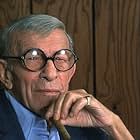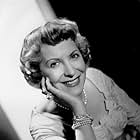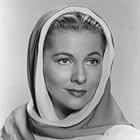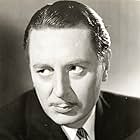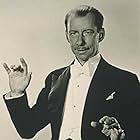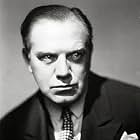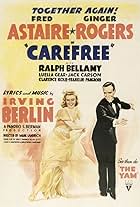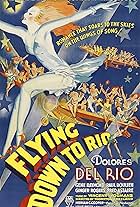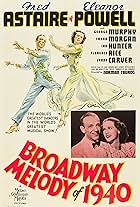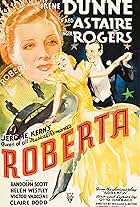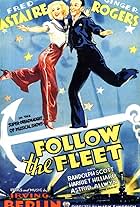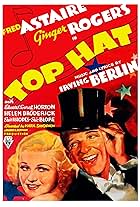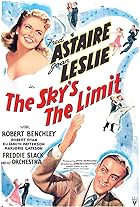IMDb RATING
6.8/10
2.4K
YOUR RATING
A betting castle staff, and a series of misunderstandings and set-ups, leads to an American entertainer and an English damsel falling in love.A betting castle staff, and a series of misunderstandings and set-ups, leads to an American entertainer and an English damsel falling in love.A betting castle staff, and a series of misunderstandings and set-ups, leads to an American entertainer and an English damsel falling in love.
- Won 1 Oscar
- 1 win & 1 nomination total
Pearl Amatore
- Madrigal Singer
- (uncredited)
Dorothy Barrett
- Dancer in Funhouse Number
- (uncredited)
May Beatty
- Landlady
- (uncredited)
Eugene Beday
- Bit Role
- (uncredited)
Charles Bennett
- Carnival Barker
- (uncredited)
Frank Benson
- Attendant
- (uncredited)
John Blood
- Bit Role
- (uncredited)
Angela Blue
- Dancer
- (uncredited)
Storyline
Did you know
- TriviaWhen Fred Astaire learned that Gracie Allen was nervous about dancing with him on-stage, he reportedly made a point of tripping and falling in front of her the first day on the set to put her at her ease.
- GoofsThis movie is based in England where vehicles drive on the left, but all the vehicles are left-hand drive, which obviously is what side they drive on in the US.
- ConnectionsFeatured in Hollywood and the Stars: The Fabulous Musicals (1963)
- SoundtracksI Can't Be Bothered Now
(1937) (uncredited)
Words by Ira Gershwin
Music by George Gershwin
Song and dance performed by Fred Astaire
Featured review
Rarely does a novelist have the opportunity to participate in the adaptation of one of his own stories for the screen, but such was the case with Pelham Grenville Wodehouse (1881-1975). The 1937 movie, A DAMSEL IN DISTRESS, was the first and only time he assisted in transposing his prose to film.
A Damsel in Distress had initially been filmed back in 1919, at the time of its original publication, in a version faithful to the novel. In 1928 Wodehouse had collaborated on a stage version with Ian Hay, which had condensed and rearranged some scenes for the limitations of the proscenium, while retaining the highlights of the book. On the advice of George Gershwin, RKO producer Pandro Berman bought the screen rights to A Damsel in Distress in November 1936. Gershwin had collaborated in the theater with Wodehouse before he wrote the novel, and Gershwin believed that the character of the music writer named George Bevan in A Damsel in Distress was based on him. Gershwin's nine songs for the film were composed before the script was written, and he actually died during production of the movie. A DAMSEL IN DISTRESS had an unusual follow-up: in 1998, the score of the film, along with several songs Gershwin had written but which were not used in the picture, were included in a new stage musical of the Wodehouse novel, this time entitled A Foggy Day for one of the songs.
RKO was interested in filming A Damsel in Distress because the novel's romantic lead was a musical comedy composer, allowing a singer and dancer to be cast in the role--and RKO needed a Fred Astaire vehicle. Scripting was already well underway when Wodehouse was asked to assist in May 1937, and shooting took place from July 22 to October 16, while work on the script continued until September 25 (Wodehouse left on August 14). The recurring gag of everyone infectiously saying "Right-ho" to one another seems a nod to Wodehouse's presence on the movie. Similarly, the song "Stiff Upper Lip" is the most colloquial in its wording, and reminiscent of the Wodehouse prose in its lyrics. Like the Ian Hay stage version, A DAMSEL IN DISTRESS retained the basic plot outline of the novel, but unlike the play, the movie also deleted and merged a number of the characters, and added others, becoming a second, separate Wodehouse variation on the novel. Ideas from the novel are used, but combined with fresh material, as the movie increasingly strays from the source. To add box-office insurance, George Burns and Gracie Allen were brought in from Paramount to partner Astaire in gags and dance routines. Burns and Allen play Jerry's press agent and his secretary, using their own names as they did in most of their movies of this time. While their participation was definitely outside the original, and the humor different from the Wodehouse style, Burns and Allen provide the movie with additional amusement.
Joan Fontaine was cast opposite Astaire. She had just been placed under contract to RKO, and was only then emerging from low-budget films; her first successful starring role would not be until1940 with REBECCA. The casting of Burns and Allen was partly to compensate for the risk associated with placing a relative unknown as the love interest. Whereas previous Astaire films had emphasized a partnership, and the grace of the romantic dancing duet with Ginger Rogers, A DAMSEL IN DISTRESS placed Astaire front and center, emphasizing the solitary aspect of his performance. Fontaine and Astaire have only one brief number together, simultaneously inviting comparison with Rogers yet demonstrating that she was unable to dance adequately opposite Astaire. Only the presence of Burns and Allen keep the entire picture from pivoting entirely on Astaire. The expectations of a romantic musical comedy usually call for a couple at the center, but A DAMSEL IN DISTRESS opts for a solitary lead, or at most a trio (when Burns and Allen are also on screen)-an inherent imbalance in the genre. Fontaine believed that the movie actually set her career back several years. Reginald Gardiner had played the role of Percy, the antagonist in the romances, in the Hay version on the London stage. In the movie, by contrast, the character of Percy is eliminated, and Gardiner is cast as Keggs the butler, who becomes a much more sprightly and unlikely character than in the novel. Gardiner was an ideal choice, an English comedian in the same tradition as Wodehouse. A major screen credit seemed to open up the possibility of a new career for Wodehouse, but when A DAMSEL IN DISTRESS was released on November 19, it proved to be the first Astaire picture to lose money at the box office. This was probably inevitable; after seven vehicles together, audiences had grown accustomed to seeing Astaire paired with Ginger Rogers, and reviewers inevitably compared Fontaine unfavorably. The failure of A DAMSEL IN DISTRESS would compel Astaire to make two more movies with Rogers, although their reunion in CAREFREE (1938) also met with a lukewarm box office reception. Hence, the reaction to A DAMSEL IN DISTRESS was hardly unique for an Astaire picture at this point in his career. However, the disappointing box-office results must have stung Wodehouse, not only because of his involvement in its creation, but because his name had become a more prominent part of advertising and promotion than on any of the previous films from his novels. Subsequently, few movies were made from Wodehouse sources, although in decades to come he would be far more successfully adapted for television.
A Damsel in Distress had initially been filmed back in 1919, at the time of its original publication, in a version faithful to the novel. In 1928 Wodehouse had collaborated on a stage version with Ian Hay, which had condensed and rearranged some scenes for the limitations of the proscenium, while retaining the highlights of the book. On the advice of George Gershwin, RKO producer Pandro Berman bought the screen rights to A Damsel in Distress in November 1936. Gershwin had collaborated in the theater with Wodehouse before he wrote the novel, and Gershwin believed that the character of the music writer named George Bevan in A Damsel in Distress was based on him. Gershwin's nine songs for the film were composed before the script was written, and he actually died during production of the movie. A DAMSEL IN DISTRESS had an unusual follow-up: in 1998, the score of the film, along with several songs Gershwin had written but which were not used in the picture, were included in a new stage musical of the Wodehouse novel, this time entitled A Foggy Day for one of the songs.
RKO was interested in filming A Damsel in Distress because the novel's romantic lead was a musical comedy composer, allowing a singer and dancer to be cast in the role--and RKO needed a Fred Astaire vehicle. Scripting was already well underway when Wodehouse was asked to assist in May 1937, and shooting took place from July 22 to October 16, while work on the script continued until September 25 (Wodehouse left on August 14). The recurring gag of everyone infectiously saying "Right-ho" to one another seems a nod to Wodehouse's presence on the movie. Similarly, the song "Stiff Upper Lip" is the most colloquial in its wording, and reminiscent of the Wodehouse prose in its lyrics. Like the Ian Hay stage version, A DAMSEL IN DISTRESS retained the basic plot outline of the novel, but unlike the play, the movie also deleted and merged a number of the characters, and added others, becoming a second, separate Wodehouse variation on the novel. Ideas from the novel are used, but combined with fresh material, as the movie increasingly strays from the source. To add box-office insurance, George Burns and Gracie Allen were brought in from Paramount to partner Astaire in gags and dance routines. Burns and Allen play Jerry's press agent and his secretary, using their own names as they did in most of their movies of this time. While their participation was definitely outside the original, and the humor different from the Wodehouse style, Burns and Allen provide the movie with additional amusement.
Joan Fontaine was cast opposite Astaire. She had just been placed under contract to RKO, and was only then emerging from low-budget films; her first successful starring role would not be until1940 with REBECCA. The casting of Burns and Allen was partly to compensate for the risk associated with placing a relative unknown as the love interest. Whereas previous Astaire films had emphasized a partnership, and the grace of the romantic dancing duet with Ginger Rogers, A DAMSEL IN DISTRESS placed Astaire front and center, emphasizing the solitary aspect of his performance. Fontaine and Astaire have only one brief number together, simultaneously inviting comparison with Rogers yet demonstrating that she was unable to dance adequately opposite Astaire. Only the presence of Burns and Allen keep the entire picture from pivoting entirely on Astaire. The expectations of a romantic musical comedy usually call for a couple at the center, but A DAMSEL IN DISTRESS opts for a solitary lead, or at most a trio (when Burns and Allen are also on screen)-an inherent imbalance in the genre. Fontaine believed that the movie actually set her career back several years. Reginald Gardiner had played the role of Percy, the antagonist in the romances, in the Hay version on the London stage. In the movie, by contrast, the character of Percy is eliminated, and Gardiner is cast as Keggs the butler, who becomes a much more sprightly and unlikely character than in the novel. Gardiner was an ideal choice, an English comedian in the same tradition as Wodehouse. A major screen credit seemed to open up the possibility of a new career for Wodehouse, but when A DAMSEL IN DISTRESS was released on November 19, it proved to be the first Astaire picture to lose money at the box office. This was probably inevitable; after seven vehicles together, audiences had grown accustomed to seeing Astaire paired with Ginger Rogers, and reviewers inevitably compared Fontaine unfavorably. The failure of A DAMSEL IN DISTRESS would compel Astaire to make two more movies with Rogers, although their reunion in CAREFREE (1938) also met with a lukewarm box office reception. Hence, the reaction to A DAMSEL IN DISTRESS was hardly unique for an Astaire picture at this point in his career. However, the disappointing box-office results must have stung Wodehouse, not only because of his involvement in its creation, but because his name had become a more prominent part of advertising and promotion than on any of the previous films from his novels. Subsequently, few movies were made from Wodehouse sources, although in decades to come he would be far more successfully adapted for television.
- briantaves
- Oct 12, 2004
- Permalink
- How long is A Damsel in Distress?Powered by Alexa
Details
Box office
- Budget
- $1,035,000 (estimated)
- Runtime1 hour 41 minutes
- Color
- Aspect ratio
- 1.37 : 1
Contribute to this page
Suggest an edit or add missing content










